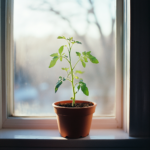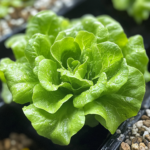Vertical gardening is perfect for those with limited space, allowing you to grow plants upward instead of outward. This innovative approach makes use of walls, fences, and other vertical surfaces, creating beautiful, space-saving gardens. Learn how to start your own vertical garden and enjoy the benefits of maximizing your space.
Why Choose Vertical Gardening?
Vertical gardening is an innovative and practical approach to gardening that offers numerous benefits, especially for urban gardeners:
- Space Optimization: Perfect for small or narrow spaces, vertical gardening allows you to grow more plants by utilizing vertical surfaces.
- Aesthetic Appeal: Vertical gardens create a stunning visual impact, adding greenery and beauty to walls, fences, and other vertical surfaces.
- Improved Air Quality: By adding more plants to your living space, vertical gardens help improve air quality by filtering pollutants and increasing oxygen levels.
- Easy Maintenance: Plants grown vertically are often easier to maintain, harvest, and care for, as they are at eye level, reducing the need for bending or kneeling.
- Pest and Disease Control: Elevating plants can help reduce issues with ground-dwelling pests and improve air circulation, which can lower the risk of fungal diseases.
Introduction to Vertical Gardening: What You Need to Know
Before you start your vertical garden, it’s important to understand the basics:
- Choosing a Location: Select a location that receives the right amount of sunlight for your chosen plants. Most vegetables and flowering plants require at least 6-8 hours of sunlight per day. Consider walls, fences, railings, or even indoor spaces near windows.
- Support Structures: Vertical gardens need support structures such as trellises, stakes, hanging baskets, or wall-mounted planters. Choose sturdy materials that can bear the weight of the plants, soil, and water.
- Watering and Irrigation: Vertical gardens can dry out faster than traditional gardens due to gravity and exposure. Drip irrigation systems or self-watering planters are great options to ensure consistent moisture.
- Soil and Fertilizer: Use high-quality potting soil that drains well and retains moisture. Since vertical gardens have limited soil, regular fertilization is important to provide essential nutrients.
Best Plants for Vertical Gardens in Urban Spaces
Not all plants are suited for vertical gardening, so choosing the right ones is key to success. Here are some of the best options:
- Vegetables:
- Tomatoes: Indeterminate varieties grow tall and need support, making them ideal for vertical gardening.
- Cucumbers: These climbing plants thrive on trellises and produce abundant harvests.
- Peas and Beans: Naturally vining, these plants are perfect for growing vertically.
- Leafy Greens: Lettuce, spinach, and kale can be grown in vertical planters or hanging baskets.
- Herbs:
- Basil, oregano, thyme, and rosemary are great herbs for vertical gardens. They thrive in small containers and are easy to maintain.
- Flowers:
- Petunias, nasturtiums, and marigolds add color and beauty to vertical gardens and attract beneficial pollinators.
- Fruits:
- Strawberries: These can be grown in vertical towers or wall-mounted planters for easy harvesting.
- Dwarf Citrus Trees: While not completely vertical, compact varieties can be grown in pots supported by stakes.
DIY Vertical Gardening Projects for Beginners
Starting a vertical garden doesn’t have to be expensive or complicated. Here are some DIY ideas to get you started:
- Pallet Garden: Repurpose an old wooden pallet by attaching it to a wall or fence. Add landscape fabric to create planting pockets and fill them with soil and plants. This is a cost-effective and creative way to grow herbs, flowers, or small vegetables.
- Hanging Baskets: Use hanging baskets to create a tiered garden effect. This works well for trailing plants like strawberries or cascading flowers.
- Wall Planters: Install wall-mounted planters or pocket planters on an outdoor wall. These are perfect for herbs and small flowers, and they make a beautiful living wall.
- Gutter Garden: Attach old gutters horizontally on a fence or wall and use them as planters. This is an innovative way to grow shallow-rooted plants like lettuce and herbs.
- Trellis with Pots: Set up a trellis against a wall and hang small pots from it. This is ideal for growing a mix of herbs, flowers, and small vegetables.
How to Build a Vertical Garden on Your Balcony
Creating a vertical garden on a balcony is a great way to maximize space and bring greenery to your living area. Here’s how to do it:
- Choose the Right Spot: Select a section of the balcony that gets enough sunlight for your chosen plants. Ensure there is enough space to move around and access plants for maintenance.
- Install Supports: Use a freestanding trellis, a series of hooks for hanging baskets, or a vertical planter that can be attached to the balcony railing.
- Select Containers: Choose containers suitable for the size of your plants and that fit your chosen support structure. Consider lightweight materials like plastic or fabric grow bags.
- Plant Selection: Choose a variety of plants that suit your light conditions and balcony size. Mix trailing plants with upright growers to create a visually appealing garden.
- Watering Setup: Use drip irrigation or self-watering planters to ensure your vertical garden receives consistent moisture, especially during hot weather.
Vertical Gardening Maintenance Tips: Keeping Your Plants Healthy
Vertical GardeningTo ensure your vertical garden thrives, follow these maintenance tips:
- Regular Watering: Check the moisture level of your vertical garden daily, especially during hot or dry periods. Vertical gardens can dry out quickly, so consistent watering is key.
- Fertilizing: Use a balanced, water-soluble fertilizer every 4-6 weeks to replenish nutrients. Organic compost tea can also be a great addition.
- Pruning and Training: Regularly prune and train your plants to grow vertically. Remove dead leaves and spent flowers to encourage new growth and prevent diseases.
- Pest Control: Monitor your vertical garden for pests. Use organic pest control methods such as neem oil, insecticidal soap, or introduce natural predators like ladybugs.
- Check Supports: Regularly inspect your support structures to ensure they are sturdy and can handle the weight of the growing plants. Adjust ties or clips as needed.
Conclusion
Vertical gardening is an innovative way to maximize space, enhance your living environment, and enjoy the benefits of gardening even in urban settings. By choosing the right plants, support structures, and following simple maintenance tips, you can create a thriving vertical garden that adds beauty, freshness, and greenery to your home.




